Welding Machinery Market
Welding Machinery Market Size and Share Forecast Outlook 2025 to 2035
Welding machinery market is projected to grow from USD 15.0 billion in 2025 to USD 21.0 billion by 2035, at a CAGR of 3.4%. MIG/MAG will dominate with a 38.0% market share, while inverter will lead the power segment with a 63.0% share.
Welding Machinery Market Forecast and Outlook 2025 to 2035
The global welding machinery market is valued at USD 15.0 billion in 2025. It is slated to reach USD 21.0 billion by 2035, recording an absolute increase of USD 6.0 billion over the forecast period. This translates into a total growth of 40.0%, with the market forecast to expand at a compound annual growth rate (CAGR) of 3.4% between 2025 and 2035.
The overall market size is expected to grow by nearly 1.40X during the same period, supported by increasing infrastructure development, growing automotive manufacturing, expanding shipbuilding industry, and rising adoption of advanced welding technologies across diverse industrial and construction applications.
Quick Stats for Welding Machinery Market
- Welding Machinery Market Value (2025): USD 15.0 billion
- Welding Machinery Market Forecast Value (2035): USD 21.0 billion
- Welding Machinery Market Forecast CAGR: 3.4%
- Leading Process Type in Welding Machinery Market: MIG/MAG
- Key Growth Regions in Welding Machinery Market: Asia-Pacific, North America, and Europe
- Key Players in Welding Machinery Market: Lincoln Electric, ESAB, Miller Electric, Fronius, Panasonic Welding, Kemppi
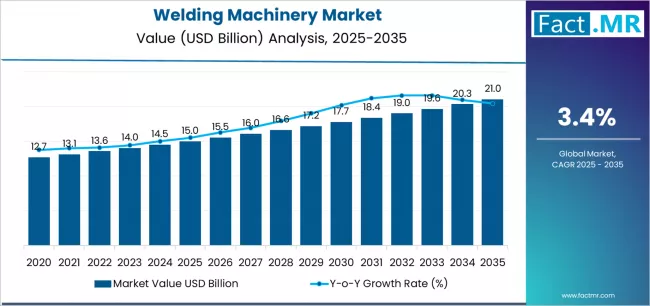
The welding machinery market growth is strongly driven by technological advancements that enhance efficiency, precision, and safety in industrial operations. Modern welding solutions, such as robotic welding systems, laser welding, and automated arc welding machines, are gaining prominence due to their ability to deliver consistent quality while reducing labor dependency and operational errors. The integration of Industry 4.0 concepts, including IoT-enabled welding equipment and real-time monitoring systems, is further facilitating predictive maintenance, minimizing downtime, and optimizing production throughput across automotive, aerospace, and heavy machinery sectors.
In the automotive industry, rising vehicle production, especially electric vehicles (EVs) and hybrid models, is fueling demand for precision welding machinery capable of joining lightweight materials such as aluminum, stainless steel, and high-strength steel. Manufacturers are increasingly investing in automated welding systems to meet stringent safety and quality standards while improving manufacturing speed. The shipbuilding and marine construction sectors are adopting advanced welding technologies to improve structural integrity, reduce corrosion risk, and accelerate assembly timelines.
Infrastructure development across emerging economies is also playing a significant role in market expansion. Urbanization, government-funded construction projects, and investments in transportation networks, bridges, and energy infrastructure require robust welding equipment to ensure durability and compliance with engineering standards. The energy sector, including oil & gas and renewable power plants, relies on welding machinery for pipeline construction, storage tanks, wind turbine components, and solar frame assembly, further boosting demand.
Regionally, Asia-Pacific is expected to emerge as the fastest-growing market due to rapid industrialization, expansion of manufacturing hubs, and government incentives promoting infrastructure growth. North America and Europe continue to maintain steady growth, driven by advanced manufacturing practices, regulatory compliance, and the adoption of smart welding solutions.
Market dynamics are further shaped by mergers, acquisitions, and partnerships among key players to expand product portfolios and enter new geographic markets. Emphasis on R&D has led to the development of lightweight, energy-efficient, and environmentally friendly welding machines, addressing sustainability concerns while enhancing productivity. With continuous innovation, increased automation, and rising demand from multiple end-use industries, the welding machinery market is poised for sustained growth, becoming a cornerstone of industrial modernization and global manufacturing efficiency over the next decade.
Between 2025 and 2030, the welding machinery market is projected to expand from USD 15.0 billion to USD 17.8 billion, resulting in a value increase of USD 2.8 billion, which represents 46.7% of the total forecast growth for the decade.
This phase of development will be shaped by increasing infrastructure projects, growing industrial automation, and expanding manufacturing capacity across emerging markets. Welding equipment manufacturers and industrial companies are expanding their machinery capabilities to address the growing demand for efficient and reliable welding solutions.
Welding Machinery Market Key Takeaways
| Metric | Value |
|---|---|
| Estimated Value in (2025E) | USD 15.0 billion |
| Forecast Value in (2035F) | USD 21.0 billion |
| Forecast CAGR (2025 to 2035) | 3.4% |
From 2030 to 2035, the market is forecast to grow from USD 17.8 billion to USD 21.0 billion, adding another USD 3.2 billion, which constitutes 53.3% of the overall ten-year expansion. This period is expected to be characterized by the expansion of automated welding systems, development of smart welding technologies, and growth of integrated manufacturing solutions. The growing adoption of Industry 4.0 principles and digital welding processes will drive demand for welding machinery with enhanced automation and connectivity capabilities.
Between 2020 and 2025, the welding machinery market experienced recovery and growth, driven by infrastructure investment recovery and growing recognition of welding machinery as essential equipment for manufacturing and construction industries.
The market developed as manufacturers and contractors recognized the potential for advanced welding technology to improve productivity, ensure quality consistency, and support diverse material joining requirements while maintaining operational efficiency and cost effectiveness.
Why is the Welding Machinery Market Growing?
Market expansion is being supported by the increasing global infrastructure development driven by urbanization and economic growth, alongside the corresponding need for reliable metal joining solutions that can ensure structural integrity, improve productivity, and support diverse fabrication requirements across various construction, manufacturing, and industrial applications.
Modern fabricators and manufacturers are increasingly focused on implementing welding machinery solutions that can optimize production efficiency, improve weld quality, and provide comprehensive joining capabilities while maintaining operational reliability and cost competitiveness.
The growing emphasis on manufacturing automation and quality control is driving demand for welding machinery that can support consistent weld quality, enable automated production processes, and ensure comprehensive quality assurance through advanced control systems and monitoring technologies.
Manufacturers' preference for equipment that combines productivity enhancement with quality reliability and operational efficiency is creating opportunities for innovative welding machinery implementations. The rising influence of advanced materials and precision manufacturing requirements is also contributing to increased adoption of welding machinery that can provide superior welding performance without compromising material properties or structural integrity.
Segmental Analysis
The market is segmented by process, power, and end use. By process, the market is divided into MIG/MAG, TIG, and resistance/spot & others. Based on power, the market is categorized into inverter and transformer technologies. By end use, the market is segmented into automotive, construction, and heavy fabrication applications.
By Process, the MIG/MAG Segment Leads the Market
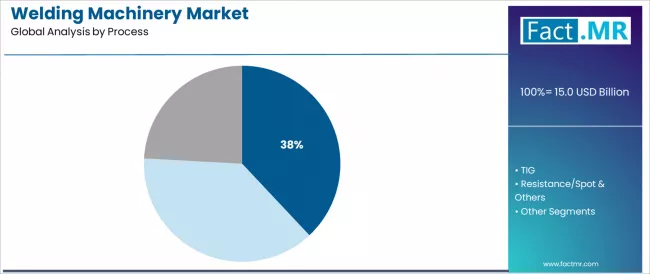
The MIG/MAG segment is projected to maintain its leading position in the welding machinery market in 2025 with a 38.0% market share, reaffirming its role as the preferred welding process for industrial and construction applications due to versatility and productivity advantages.
Welding operators and manufacturers increasingly utilize MIG/MAG processes for their high deposition rates, ease of automation, and proven effectiveness in joining various metal types while maintaining weld quality and operational efficiency. MIG/MAG welding technology's proven effectiveness and versatility directly address industry requirements for productive welding and consistent quality across diverse material applications and production environments.
This process segment forms the foundation of modern industrial welding, as it represents the technology with the greatest contribution to production efficiency and established performance record across multiple manufacturing sectors and fabrication requirements.
Welding industry investments in MIG/MAG technologies continue to strengthen adoption among manufacturers and fabricators. With industrial requirements demanding productivity and quality consistency, MIG/MAG processes align with both efficiency objectives and quality assurance requirements, making them the central component of comprehensive welding operation strategies.
By Power, the Inverter Segment Dominates Market Demand
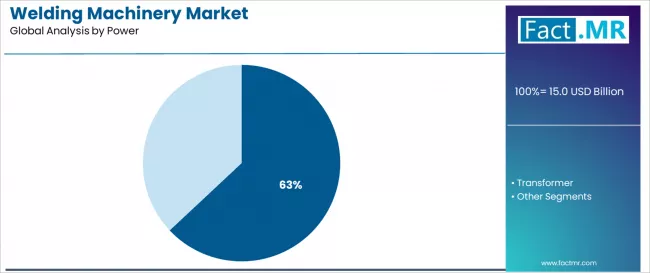
The inverter power segment is projected to represent the largest share of welding machinery demand in 2025 with a 63.0% market share, underscoring its critical role as the preferred power technology for modern welding equipment due to energy efficiency and advanced control capabilities.
Manufacturers prefer inverter technology for welding machinery due to its superior energy efficiency, precise arc control, and proven effectiveness in providing stable welding performance while supporting advanced features and portable operation. Positioned as the modern standard for welding power sources, inverter technology offers both efficiency advantages and performance enhancement benefits.
The segment is supported by continuous innovation in power electronics and the growing availability of advanced inverter systems that enable superior welding performance with enhanced control precision and energy optimization.
Welding equipment manufacturers are investing in comprehensive inverter development programs to support increasingly sophisticated welding requirements and efficiency optimization demands. As energy costs increase and welding precision becomes more important, the inverter power segment will continue to dominate the market while supporting advanced welding control and operational efficiency optimization.
What are the Drivers, Restraints, and Key Trends of the Welding Machinery Market?
The welding machinery market is advancing steadily due to increasing infrastructure development driven by urbanization and economic growth, alongside growing demand for automated welding solutions that provide productivity enhancement, quality improvement, and operational efficiency across various manufacturing, construction, and industrial applications.
The market faces challenges, including skilled welder shortages affecting equipment utilization, high initial investment costs for advanced systems, and competition from alternative joining technologies. Innovation in automated welding systems and user-friendly interfaces continues to influence equipment adoption and operational optimization patterns.
Expansion of Infrastructure Development and Construction Activity
The growing infrastructure development is driving demand for welding machinery that can support large-scale construction projects, structural fabrication, and industrial facility development through high-capacity welding equipment and reliable production capabilities.
Construction contractors require welding machinery that delivers consistent performance across extended project timelines while maintaining productivity and quality standards for diverse structural applications. Fabrication companies are increasingly recognizing the competitive advantages of advanced welding equipment for project efficiency and quality assurance, creating opportunities for specialized machinery designed for construction and infrastructure applications.
Integration of Automation and Digital Technologies
Modern welding machinery manufacturers are incorporating automation technologies and digital control systems to enhance welding consistency, reduce skill requirements, and support comprehensive quality monitoring through intelligent welding control and automated process optimization.
Leading companies are developing robotic welding systems, implementing IoT connectivity, and advancing digital welding management that optimizes welding parameters while reducing operator dependency and improving quality consistency. These technologies improve operational efficiency while enabling new manufacturing opportunities, including lights-out welding, remote monitoring, and data-driven process optimization.
Development of Advanced Materials and Specialized Applications
The expansion of advanced materials and specialized manufacturing requirements is driving demand for welding machinery with enhanced capabilities for joining high-strength steels, aluminum alloys, and exotic materials that require precise welding control and specialized process capabilities.
These advanced applications require sophisticated welding technologies and precise parameter control that exceed traditional welding equipment capabilities, creating premium market segments with enhanced performance requirements. Manufacturers are investing in advanced welding technology development and specialized capabilities to serve demanding applications while supporting innovation in advanced manufacturing and material processing.
Analysis of the Welding Machinery Market by Key Countries
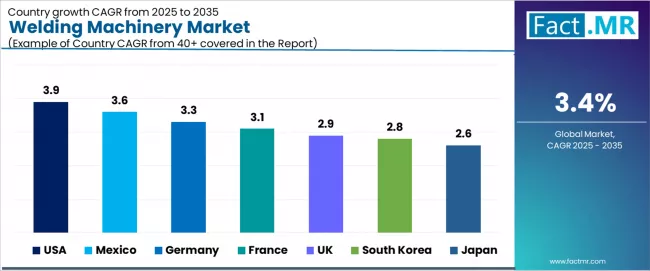
| Country | CAGR (2025-2035) |
|---|---|
| USA | 3.9% |
| Mexico | 3.6% |
| Germany | 3.3% |
| France | 3.1% |
| UK | 2.9% |
| South Korea | 2.8% |
| Japan | 2.6% |
The welding machinery market is experiencing solid growth globally, with the USA leading at a 3.9% CAGR through 2035, driven by infrastructure investment, manufacturing reshoring, and construction industry recovery supporting welding equipment demand. Mexico follows at 3.6%, supported by expanding manufacturing sector, automotive production growth, and increasing industrial development. Germany shows growth at 3.3%, emphasizing manufacturing excellence, automotive industry strength, and advanced welding technology development. France demonstrates 3.1% growth, supported by industrial development, construction activity, and manufacturing modernization. The UK records 2.9%, focusing on construction recovery, manufacturing efficiency, and infrastructure investment. South Korea exhibits 2.8% growth, emphasizing shipbuilding excellence and industrial manufacturing. Japan shows 2.6% growth, supported by precision manufacturing and advanced welding applications.
USA Leads Global Market Growth with Manufacturing and Infrastructure Strength
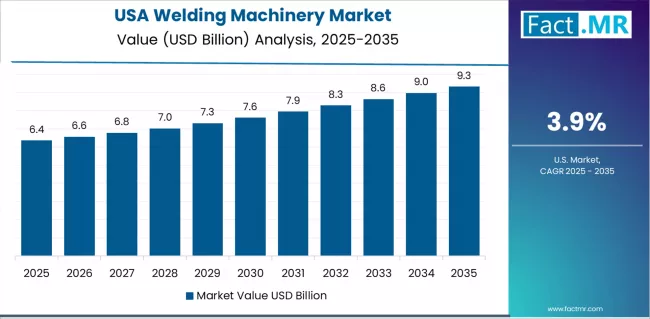
Revenue from welding machinery in the USA is projected to exhibit strong growth with a CAGR of 3.9% through 2035, driven by infrastructure investment programs and rapidly growing manufacturing reshoring supporting welding equipment adoption among construction companies, manufacturing facilities, and industrial contractors. The country's established manufacturing infrastructure and increasing infrastructure focus are creating substantial demand for welding machinery solutions. Major equipment manufacturers and welding service providers are establishing comprehensive supply capabilities to serve both industrial and construction market opportunities.
- Strong infrastructure investment and construction industry recovery are driving demand for welding machinery throughout construction contractors, fabrication shops, and infrastructure projects across major metropolitan areas and industrial regions.
- Growing manufacturing reshoring and industrial development are supporting the rapid adoption of advanced welding technologies among manufacturers seeking productivity enhancement and competitive advantages in domestic production capabilities.
Mexico Demonstrates Strong Market Potential with Manufacturing Expansion
Revenue from welding machinery in Mexico is expanding at a CAGR of 3.6%, supported by the country's expanding manufacturing sector, growing automotive production, and increasing industrial development driving demand for welding equipment and fabrication capabilities. The country's manufacturing growth and strategic advantages are driving demand for welding machinery throughout various industrial sectors. Leading manufacturing companies and equipment suppliers are establishing comprehensive production facilities to address growing manufacturing and export demands.
- Strong manufacturing sector expansion and automotive production growth are creating opportunities for welding machinery adoption across manufacturing facilities, automotive suppliers, and industrial operations in major manufacturing regions.
- Growing industrial development and infrastructure projects are driving adoption of reliable welding equipment among contractors and manufacturers seeking improved productivity and competitive positioning in expanding industrial markets.
Germany Demonstrates Engineering Excellence with Automotive Leadership
Revenue from welding machinery in Germany is expanding at a CAGR of 3.3%, driven by the country's manufacturing excellence, automotive industry strength, and comprehensive advanced welding technology development supporting sophisticated welding machinery utilization. Germany's engineering expertise and automotive leadership are driving demand for premium welding machinery solutions. Leading equipment manufacturers and automotive suppliers are establishing comprehensive innovation programs for advanced welding applications.
- Advanced manufacturing standards and automotive industry requirements are creating demand for sophisticated welding machinery among automotive manufacturers seeking superior quality and engineering excellence in competitive global markets.
- Strong engineering capabilities and welding technology leadership are supporting the adoption of premium welding equipment across high-performance applications and precision manufacturing throughout major industrial regions.
France Focuses on Industrial Development and Manufacturing Modernization
Revenue from welding machinery in France is expanding at a CAGR of 3.1%, driven by the country's industrial development initiatives, construction activity growth, and comprehensive approach to manufacturing modernization supporting welding machinery integration into modern production facilities. France's industrial capabilities and manufacturing standards are supporting investment in advanced welding technologies. Major industrial companies and manufacturing facilities are establishing comprehensive modernization programs incorporating advanced welding equipment.
- Advanced industrial development and manufacturing modernization requirements are creating demand for welding machinery throughout manufacturing facilities, construction companies, and industrial projects serving modern production standards.
- Strong construction activity and infrastructure development are driving the adoption of reliable welding equipment across construction applications and industrial facility development meeting French quality and performance requirements.
UK Shows Market Leadership with Construction Recovery and Manufacturing Efficiency
Revenue from welding machinery in the UK is expanding at a CAGR of 2.9%, supported by the country's construction industry recovery, manufacturing efficiency initiatives, and comprehensive approach to infrastructure investment supporting welding machinery utilization across construction and manufacturing applications. The UK's construction recovery and manufacturing focus are driving demand for efficient welding solutions. Leading construction companies and manufacturers are investing in advanced welding equipment and production efficiency improvements.
- Strong construction recovery and infrastructure investment are creating opportunities for welding machinery throughout construction contractors, fabrication shops, and infrastructure projects serving recovery-focused market segments.
- Advanced manufacturing efficiency focus and production modernization trends are driving the adoption of advanced welding equipment across manufacturing facilities seeking enhanced productivity and operational excellence.
South Korea Demonstrates Industrial Excellence with Shipbuilding Leadership
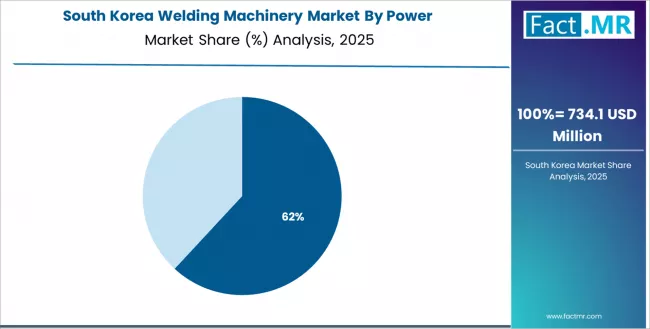
Revenue from welding machinery in South Korea is expanding at a CAGR of 2.8%, supported by the country's shipbuilding excellence, industrial manufacturing capabilities, and strong emphasis on heavy industry and precision fabrication supporting advanced welding machinery adoption. The nation's shipbuilding leadership and industrial expertise are driving demand for specialized welding solutions. Leading shipbuilding companies are investing extensively in advanced welding capabilities and heavy fabrication technologies.
- Strong shipbuilding industry and heavy fabrication capabilities are creating demand for advanced welding machinery throughout shipyards, heavy industry facilities, and precision fabrication operations serving specialized industrial requirements.
- Advanced industrial manufacturing and precision fabrication focus are supporting the adoption of sophisticated welding equipment designed for heavy industry applications and specialized manufacturing requirements.
Japan Shows Premium Focus with Precision Manufacturing Applications
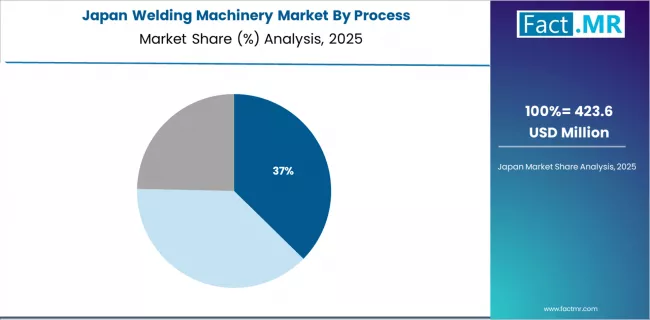
Revenue from welding machinery in Japan is expanding at a CAGR of 2.6%, supported by the country's precision manufacturing excellence, advanced welding technology development, and strong emphasis on quality and technological sophistication supporting premium welding machinery utilization. Japan's technological expertise and manufacturing precision are driving demand for specialized welding equipment products. Leading technology companies are investing in advanced capabilities for precision welding applications and manufacturing excellence.
- Advanced precision manufacturing and quality focus are creating opportunities for premium welding machinery throughout high-end manufacturing facilities and precision fabrication operations serving specialized requirements.
- Strong technological excellence and manufacturing sophistication are driving adoption of advanced welding systems meeting Japanese standards for precision and superior performance across diverse manufacturing applications.
Europe Market Split by Country
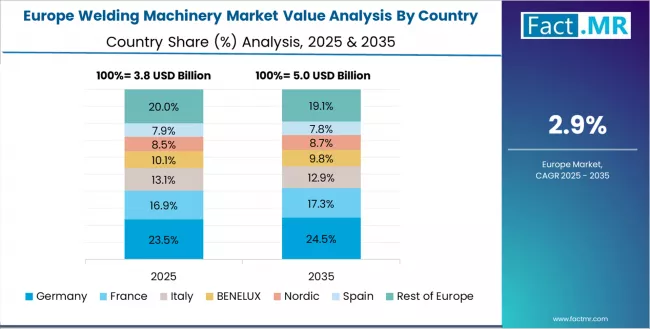
The welding machinery market in Europe is projected to grow from USD 4.8 billion in 2025 to USD 6.5 billion by 2035, registering a CAGR of 3.1% over the forecast period. Germany is expected to maintain leadership with a 33.3% market share in 2025, moderating to 33.1% by 2035, supported by manufacturing excellence, automotive industry strength, and advanced welding technology development.
France follows with 19.8% in 2025, projected to reach 20.0% by 2035, driven by industrial development, construction activity, and manufacturing modernization initiatives. Italy holds 16.7% in 2025, expected to reach 16.8% by 2035 due to manufacturing activity and industrial development. The United Kingdom commands 14.6% in 2025, rising to 14.5% by 2035, while Spain accounts for 10.4% in 2025, reaching 10.5% by 2035. The Rest of Europe region is anticipated to hold 5.2% in 2025 and 5.1% by 2035, reflecting steady welding equipment adoption in Nordic countries and emerging industrial markets in Eastern European countries.
Competitive Landscape of the Welding Machinery Market
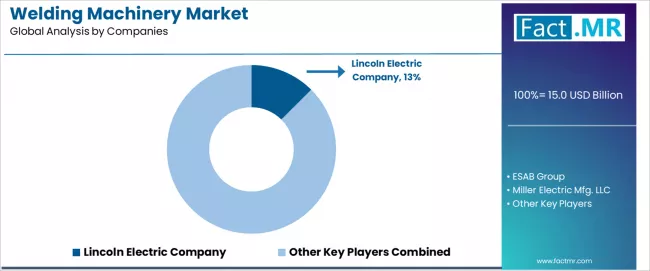
The welding machinery market is characterized by competition among established welding equipment manufacturers, industrial automation companies, and specialized welding technology providers.
Companies are investing in automation technology development, inverter power advancement, digital control system integration, and comprehensive service capabilities to deliver reliable, efficient, and user-friendly welding machinery solutions. Innovation in robotic welding systems, IoT connectivity, and advanced process control is central to strengthening market position and competitive advantage.
Lincoln Electric leads the market with a 12.5% share, offering comprehensive welding machinery solutions with focus on reliability, innovation, and extensive global service networks serving diverse industrial, construction, and manufacturing applications. The company continues investing in automation technologies and digital welding solutions while expanding production capacity and technical support capabilities.
ESAB provides advanced welding and cutting equipment with emphasis on industrial applications and automation. Miller Electric specializes in welding power sources and professional welding solutions. Fronius focuses on inverter technology and automated welding systems. Panasonic Welding emphasizes robotic welding and industrial automation. Kemppi offers advanced arc welding equipment and digital solutions.
Key Players in the Welding Machinery Market
- Lincoln Electric Company
- ESAB Group
- Miller Electric Mfg. LLC
- Fronius International GmbH
- Panasonic Welding Systems Co., Ltd.
- Kemppi Oy
- OTC Daihen Inc.
- Hyundai Welding Co., Ltd.
- Air Liquide Welding
- Böhler Welding Group
Scope of the Report
| Items | Values |
|---|---|
| Quantitative Units (2025) | USD 15.0 Billion |
| Process | MIG/MAG, TIG, Resistance/Spot & Others |
| Power | Inverter, Transformer |
| End Use | Automotive, Construction, Heavy Fabrication |
| Regions Covered | Asia-Pacific, North America, Europe, Latin America, Middle East & Africa |
| Countries Covered | USA, Mexico, Germany, France, UK, Japan, South Korea, and 40+ countries |
| Key Companies Profiled | Lincoln Electric, ESAB, Miller Electric, Fronius, Panasonic Welding, Kemppi |
| Additional Attributes | Dollar sales by process and power, regional demand trends, competitive landscape, technological advancements in welding technology, automation development, digital integration innovation, and productivity optimization |
Welding Machinery Market by Segments
-
Process :
- MIG/MAG
- TIG
- Resistance/Spot & Others
-
Power :
- Inverter
- Transformer
-
End Use :
- Automotive
- Construction
- Heavy Fabrication
-
Region :
- Asia-Pacific
- China
- Japan
- South Korea
- India
- Australia
- Rest of Asia-Pacific
- North America
- United States
- Canada
- Mexico
- Europe
- Germany
- United Kingdom
- France
- Italy
- Spain
- Netherlands
- Rest of Europe
- Latin America
- Brazil
- Argentina
- Rest of Latin America
- Middle East & Africa
- Kingdom of Saudi Arabia
- South Africa
- Rest of Middle East & Africa
- Asia-Pacific
Table of Content
- Executive Summary
- Global Market Outlook
- Demand to side Trends
- Supply to side Trends
- Technology Roadmap Analysis
- Analysis and Recommendations
- Market Overview
- Market Coverage / Taxonomy
- Market Definition / Scope / Limitations
- Market Background
- Market Dynamics
- Drivers
- Restraints
- Opportunity
- Trends
- Scenario Forecast
- Demand in Optimistic Scenario
- Demand in Likely Scenario
- Demand in Conservative Scenario
- Opportunity Map Analysis
- Product Life Cycle Analysis
- Supply Chain Analysis
- Investment Feasibility Matrix
- Value Chain Analysis
- PESTLE and Porter’s Analysis
- Regulatory Landscape
- Regional Parent Market Outlook
- Production and Consumption Statistics
- Import and Export Statistics
- Market Dynamics
- Global Market Analysis 2020 to 2024 and Forecast, 2025 to 2035
- Historical Market Size Value (USD Million) Analysis, 2020 to 2024
- Current and Future Market Size Value (USD Million) Projections, 2025 to 2035
- Y to o to Y Growth Trend Analysis
- Absolute $ Opportunity Analysis
- Global Market Pricing Analysis 2020 to 2024 and Forecast 2025 to 2035
- Global Market Analysis 2020 to 2024 and Forecast 2025 to 2035, By Process
- Introduction / Key Findings
- Historical Market Size Value (USD Million) Analysis By Process , 2020 to 2024
- Current and Future Market Size Value (USD Million) Analysis and Forecast By Process , 2025 to 2035
- MIG/MAG
- TIG
- Resistance/Spot & Others
- Y to o to Y Growth Trend Analysis By Process , 2020 to 2024
- Absolute $ Opportunity Analysis By Process , 2025 to 2035
- Global Market Analysis 2020 to 2024 and Forecast 2025 to 2035, By Power
- Introduction / Key Findings
- Historical Market Size Value (USD Million) Analysis By Power, 2020 to 2024
- Current and Future Market Size Value (USD Million) Analysis and Forecast By Power, 2025 to 2035
- Inverter
- Transformer
- Y to o to Y Growth Trend Analysis By Power, 2020 to 2024
- Absolute $ Opportunity Analysis By Power, 2025 to 2035
- Global Market Analysis 2020 to 2024 and Forecast 2025 to 2035, By Region
- Introduction
- Historical Market Size Value (USD Million) Analysis By Region, 2020 to 2024
- Current Market Size Value (USD Million) Analysis and Forecast By Region, 2025 to 2035
- North America
- Latin America
- Western Europe
- Eastern Europe
- East Asia
- South Asia and Pacific
- Middle East & Africa
- Market Attractiveness Analysis By Region
- North America Market Analysis 2020 to 2024 and Forecast 2025 to 2035, By Country
- Historical Market Size Value (USD Million) Trend Analysis By Market Taxonomy, 2020 to 2024
- Market Size Value (USD Million) Forecast By Market Taxonomy, 2025 to 2035
- By Country
- USA
- Canada
- Mexico
- By Process
- By Power
- By Country
- Market Attractiveness Analysis
- By Country
- By Process
- By Power
- Key Takeaways
- Latin America Market Analysis 2020 to 2024 and Forecast 2025 to 2035, By Country
- Historical Market Size Value (USD Million) Trend Analysis By Market Taxonomy, 2020 to 2024
- Market Size Value (USD Million) Forecast By Market Taxonomy, 2025 to 2035
- By Country
- Brazil
- Chile
- Rest of Latin America
- By Process
- By Power
- By Country
- Market Attractiveness Analysis
- By Country
- By Process
- By Power
- Key Takeaways
- Western Europe Market Analysis 2020 to 2024 and Forecast 2025 to 2035, By Country
- Historical Market Size Value (USD Million) Trend Analysis By Market Taxonomy, 2020 to 2024
- Market Size Value (USD Million) Forecast By Market Taxonomy, 2025 to 2035
- By Country
- Germany
- UK
- Italy
- Spain
- France
- Nordic
- BENELUX
- Rest of Western Europe
- By Process
- By Power
- By Country
- Market Attractiveness Analysis
- By Country
- By Process
- By Power
- Key Takeaways
- Eastern Europe Market Analysis 2020 to 2024 and Forecast 2025 to 2035, By Country
- Historical Market Size Value (USD Million) Trend Analysis By Market Taxonomy, 2020 to 2024
- Market Size Value (USD Million) Forecast By Market Taxonomy, 2025 to 2035
- By Country
- Russia
- Poland
- Hungary
- Balkan & Baltic
- Rest of Eastern Europe
- By Process
- By Power
- By Country
- Market Attractiveness Analysis
- By Country
- By Process
- By Power
- Key Takeaways
- East Asia Market Analysis 2020 to 2024 and Forecast 2025 to 2035, By Country
- Historical Market Size Value (USD Million) Trend Analysis By Market Taxonomy, 2020 to 2024
- Market Size Value (USD Million) Forecast By Market Taxonomy, 2025 to 2035
- By Country
- China
- Japan
- South Korea
- By Process
- By Power
- By Country
- Market Attractiveness Analysis
- By Country
- By Process
- By Power
- Key Takeaways
- South Asia and Pacific Market Analysis 2020 to 2024 and Forecast 2025 to 2035, By Country
- Historical Market Size Value (USD Million) Trend Analysis By Market Taxonomy, 2020 to 2024
- Market Size Value (USD Million) Forecast By Market Taxonomy, 2025 to 2035
- By Country
- India
- ASEAN
- Australia & New Zealand
- Rest of South Asia and Pacific
- By Process
- By Power
- By Country
- Market Attractiveness Analysis
- By Country
- By Process
- By Power
- Key Takeaways
- Middle East & Africa Market Analysis 2020 to 2024 and Forecast 2025 to 2035, By Country
- Historical Market Size Value (USD Million) Trend Analysis By Market Taxonomy, 2020 to 2024
- Market Size Value (USD Million) Forecast By Market Taxonomy, 2025 to 2035
- By Country
- Kingdom of Saudi Arabia
- Other GCC Countries
- Turkiye
- South Africa
- Other African Union
- Rest of Middle East & Africa
- By Process
- By Power
- By Country
- Market Attractiveness Analysis
- By Country
- By Process
- By Power
- Key Takeaways
- Key Countries Market Analysis
- USA
- Pricing Analysis
- Market Share Analysis, 2024
- By Process
- By Power
- Canada
- Pricing Analysis
- Market Share Analysis, 2024
- By Process
- By Power
- Mexico
- Pricing Analysis
- Market Share Analysis, 2024
- By Process
- By Power
- Brazil
- Pricing Analysis
- Market Share Analysis, 2024
- By Process
- By Power
- Chile
- Pricing Analysis
- Market Share Analysis, 2024
- By Process
- By Power
- Germany
- Pricing Analysis
- Market Share Analysis, 2024
- By Process
- By Power
- UK
- Pricing Analysis
- Market Share Analysis, 2024
- By Process
- By Power
- Italy
- Pricing Analysis
- Market Share Analysis, 2024
- By Process
- By Power
- Spain
- Pricing Analysis
- Market Share Analysis, 2024
- By Process
- By Power
- France
- Pricing Analysis
- Market Share Analysis, 2024
- By Process
- By Power
- India
- Pricing Analysis
- Market Share Analysis, 2024
- By Process
- By Power
- ASEAN
- Pricing Analysis
- Market Share Analysis, 2024
- By Process
- By Power
- Australia & New Zealand
- Pricing Analysis
- Market Share Analysis, 2024
- By Process
- By Power
- China
- Pricing Analysis
- Market Share Analysis, 2024
- By Process
- By Power
- Japan
- Pricing Analysis
- Market Share Analysis, 2024
- By Process
- By Power
- South Korea
- Pricing Analysis
- Market Share Analysis, 2024
- By Process
- By Power
- Russia
- Pricing Analysis
- Market Share Analysis, 2024
- By Process
- By Power
- Poland
- Pricing Analysis
- Market Share Analysis, 2024
- By Process
- By Power
- Hungary
- Pricing Analysis
- Market Share Analysis, 2024
- By Process
- By Power
- Kingdom of Saudi Arabia
- Pricing Analysis
- Market Share Analysis, 2024
- By Process
- By Power
- Turkiye
- Pricing Analysis
- Market Share Analysis, 2024
- By Process
- By Power
- South Africa
- Pricing Analysis
- Market Share Analysis, 2024
- By Process
- By Power
- USA
- Market Structure Analysis
- Competition Dashboard
- Competition Benchmarking
- Market Share Analysis of Top Players
- By Regional
- By Process
- By Power
- Competition Analysis
- Competition Deep Dive
- Lincoln Electric Company
- Overview
- Product Portfolio
- Profitability by Market Segments (Product/Age /Sales Channel/Region)
- Sales Footprint
- Strategy Overview
- Marketing Strategy
- Product Strategy
- Channel Strategy
- ESAB Group
- Miller Electric Mfg. LLC
- Fronius International GmbH
- Panasonic Welding Systems Co., Ltd.
- Kemppi Oy
- OTC Daihen Inc.
- Hyundai Welding Co., Ltd.
- Air Liquide Welding
- Böhler Welding Group
- Lincoln Electric Company
- Competition Deep Dive
- Assumptions & Acronyms Used
- Research Methodology
List Of Table
- Table 1: Global Market Value (USD Million) Forecast by Region, 2020 to 2035
- Table 2: Global Market Value (USD Million) Forecast by Process , 2020 to 2035
- Table 3: Global Market Value (USD Million) Forecast by Power, 2020 to 2035
- Table 4: North America Market Value (USD Million) Forecast by Country, 2020 to 2035
- Table 5: North America Market Value (USD Million) Forecast by Process , 2020 to 2035
- Table 6: North America Market Value (USD Million) Forecast by Power, 2020 to 2035
- Table 7: Latin America Market Value (USD Million) Forecast by Country, 2020 to 2035
- Table 8: Latin America Market Value (USD Million) Forecast by Process , 2020 to 2035
- Table 9: Latin America Market Value (USD Million) Forecast by Power, 2020 to 2035
- Table 10: Western Europe Market Value (USD Million) Forecast by Country, 2020 to 2035
- Table 11: Western Europe Market Value (USD Million) Forecast by Process , 2020 to 2035
- Table 12: Western Europe Market Value (USD Million) Forecast by Power, 2020 to 2035
- Table 13: Eastern Europe Market Value (USD Million) Forecast by Country, 2020 to 2035
- Table 14: Eastern Europe Market Value (USD Million) Forecast by Process , 2020 to 2035
- Table 15: Eastern Europe Market Value (USD Million) Forecast by Power, 2020 to 2035
- Table 16: East Asia Market Value (USD Million) Forecast by Country, 2020 to 2035
- Table 17: East Asia Market Value (USD Million) Forecast by Process , 2020 to 2035
- Table 18: East Asia Market Value (USD Million) Forecast by Power, 2020 to 2035
- Table 19: South Asia and Pacific Market Value (USD Million) Forecast by Country, 2020 to 2035
- Table 20: South Asia and Pacific Market Value (USD Million) Forecast by Process , 2020 to 2035
- Table 21: South Asia and Pacific Market Value (USD Million) Forecast by Power, 2020 to 2035
- Table 22: Middle East & Africa Market Value (USD Million) Forecast by Country, 2020 to 2035
- Table 23: Middle East & Africa Market Value (USD Million) Forecast by Process , 2020 to 2035
- Table 24: Middle East & Africa Market Value (USD Million) Forecast by Power, 2020 to 2035
List Of Figures
- Figure 1: Global Market Pricing Analysis
- Figure 2: Global Market Value (USD Million) Forecast 2020-2035
- Figure 3: Global Market Value Share and BPS Analysis by Process , 2025 and 2035
- Figure 4: Global Market Y to o to Y Growth Comparison by Process , 2025-2035
- Figure 5: Global Market Attractiveness Analysis by Process
- Figure 6: Global Market Value Share and BPS Analysis by Power, 2025 and 2035
- Figure 7: Global Market Y to o to Y Growth Comparison by Power, 2025-2035
- Figure 8: Global Market Attractiveness Analysis by Power
- Figure 9: Global Market Value (USD Million) Share and BPS Analysis by Region, 2025 and 2035
- Figure 10: Global Market Y to o to Y Growth Comparison by Region, 2025-2035
- Figure 11: Global Market Attractiveness Analysis by Region
- Figure 12: North America Market Incremental Dollar Opportunity, 2025-2035
- Figure 13: Latin America Market Incremental Dollar Opportunity, 2025-2035
- Figure 14: Western Europe Market Incremental Dollar Opportunity, 2025-2035
- Figure 15: Eastern Europe Market Incremental Dollar Opportunity, 2025-2035
- Figure 16: East Asia Market Incremental Dollar Opportunity, 2025-2035
- Figure 17: South Asia and Pacific Market Incremental Dollar Opportunity, 2025-2035
- Figure 18: Middle East & Africa Market Incremental Dollar Opportunity, 2025-2035
- Figure 19: North America Market Value Share and BPS Analysis by Country, 2025 and 2035
- Figure 20: North America Market Value Share and BPS Analysis by Process , 2025 and 2035
- Figure 21: North America Market Y to o to Y Growth Comparison by Process , 2025-2035
- Figure 22: North America Market Attractiveness Analysis by Process
- Figure 23: North America Market Value Share and BPS Analysis by Power, 2025 and 2035
- Figure 24: North America Market Y to o to Y Growth Comparison by Power, 2025-2035
- Figure 25: North America Market Attractiveness Analysis by Power
- Figure 26: Latin America Market Value Share and BPS Analysis by Country, 2025 and 2035
- Figure 27: Latin America Market Value Share and BPS Analysis by Process , 2025 and 2035
- Figure 28: Latin America Market Y to o to Y Growth Comparison by Process , 2025-2035
- Figure 29: Latin America Market Attractiveness Analysis by Process
- Figure 30: Latin America Market Value Share and BPS Analysis by Power, 2025 and 2035
- Figure 31: Latin America Market Y to o to Y Growth Comparison by Power, 2025-2035
- Figure 32: Latin America Market Attractiveness Analysis by Power
- Figure 33: Western Europe Market Value Share and BPS Analysis by Country, 2025 and 2035
- Figure 34: Western Europe Market Value Share and BPS Analysis by Process , 2025 and 2035
- Figure 35: Western Europe Market Y to o to Y Growth Comparison by Process , 2025-2035
- Figure 36: Western Europe Market Attractiveness Analysis by Process
- Figure 37: Western Europe Market Value Share and BPS Analysis by Power, 2025 and 2035
- Figure 38: Western Europe Market Y to o to Y Growth Comparison by Power, 2025-2035
- Figure 39: Western Europe Market Attractiveness Analysis by Power
- Figure 40: Eastern Europe Market Value Share and BPS Analysis by Country, 2025 and 2035
- Figure 41: Eastern Europe Market Value Share and BPS Analysis by Process , 2025 and 2035
- Figure 42: Eastern Europe Market Y to o to Y Growth Comparison by Process , 2025-2035
- Figure 43: Eastern Europe Market Attractiveness Analysis by Process
- Figure 44: Eastern Europe Market Value Share and BPS Analysis by Power, 2025 and 2035
- Figure 45: Eastern Europe Market Y to o to Y Growth Comparison by Power, 2025-2035
- Figure 46: Eastern Europe Market Attractiveness Analysis by Power
- Figure 47: East Asia Market Value Share and BPS Analysis by Country, 2025 and 2035
- Figure 48: East Asia Market Value Share and BPS Analysis by Process , 2025 and 2035
- Figure 49: East Asia Market Y to o to Y Growth Comparison by Process , 2025-2035
- Figure 50: East Asia Market Attractiveness Analysis by Process
- Figure 51: East Asia Market Value Share and BPS Analysis by Power, 2025 and 2035
- Figure 52: East Asia Market Y to o to Y Growth Comparison by Power, 2025-2035
- Figure 53: East Asia Market Attractiveness Analysis by Power
- Figure 54: South Asia and Pacific Market Value Share and BPS Analysis by Country, 2025 and 2035
- Figure 55: South Asia and Pacific Market Value Share and BPS Analysis by Process , 2025 and 2035
- Figure 56: South Asia and Pacific Market Y to o to Y Growth Comparison by Process , 2025-2035
- Figure 57: South Asia and Pacific Market Attractiveness Analysis by Process
- Figure 58: South Asia and Pacific Market Value Share and BPS Analysis by Power, 2025 and 2035
- Figure 59: South Asia and Pacific Market Y to o to Y Growth Comparison by Power, 2025-2035
- Figure 60: South Asia and Pacific Market Attractiveness Analysis by Power
- Figure 61: Middle East & Africa Market Value Share and BPS Analysis by Country, 2025 and 2035
- Figure 62: Middle East & Africa Market Value Share and BPS Analysis by Process , 2025 and 2035
- Figure 63: Middle East & Africa Market Y to o to Y Growth Comparison by Process , 2025-2035
- Figure 64: Middle East & Africa Market Attractiveness Analysis by Process
- Figure 65: Middle East & Africa Market Value Share and BPS Analysis by Power, 2025 and 2035
- Figure 66: Middle East & Africa Market Y to o to Y Growth Comparison by Power, 2025-2035
- Figure 67: Middle East & Africa Market Attractiveness Analysis by Power
- Figure 68: Global Market - Tier Structure Analysis
- Figure 69: Global Market - Company Share Analysis
- FAQs -
How big is the welding machinery market in 2025?
The global welding machinery market is estimated to be valued at USD 15.0 billion in 2025.
What will be the size of welding machinery market in 2035?
The market size for the welding machinery market is projected to reach USD 21.0 billion by 2035.
How much will be the welding machinery market growth between 2025 and 2035?
The welding machinery market is expected to grow at a 3.4% CAGR between 2025 and 2035.
What are the key product types in the welding machinery market?
The key product types in welding machinery market are mig/mag, tig and resistance/spot & others.
Which power segment to contribute significant share in the welding machinery market in 2025?
In terms of power, inverter segment to command 63.0% share in the welding machinery market in 2025.